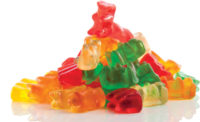How emulsifiers help with fat reduction
An in-depth look at how emulsifiers hold the confectionery world together.

Much of the confectionery industry is held together by emulsifiers — literally.
Specifically, they are the magic that combines water and fat ingredients with each other.
“In their simplest form, emulsifiers are ingredients used by food manufacturers to help create stable emulsions — most commonly between fats and water,” explains Margaret Walsh, senior scientist, Corbion. “In confectionery production – particularly chocolate, nougats, gums, taffy and fat-based gummies — emulsifiers are invaluable, with a multitude of functions.”
Wen-Juin Shieh, senior technical services manager, Cargill, says they consist of a water-loving hydrophilic or polar part, as well as a fat-loving lipophilic or non-polar part.
“As a result of this structure, the emulsifying agent settles on the interface between hydrophilic ingredients such as sugar’s surface and lipophilic substances like cocoa butter,” Shieh explains. “This enables both hydrophilic ingredients and lipophilic substances to become finely dispersed in each other, creating a stable, homogenous, smooth emulsion.”
But what does that look like in practice? Marco Oomen, global business director – Chocolate & Confectionery, AAK, breaks it down by various types of confectionery.
Caramel, Toffee, etc.: “In products containing a dispersed fat phase (caramel, toffee, etc.), emulsifiers help to promote breakdown into small fat globules. Emulsifiers also provide lubrication, in part through dispersion of the fat phase, for ease in processing and ease in consumption,” Oomen says.
Chewing and bubble gum: “In chewing and bubble gum, emulsifiers act as plasticizers of the gum base and also provide a hydration effect during chewing,” Oomen says.
Chocolate and coatings: “In fat-continuous confections, namely chocolate and coatings, emulsifiers provide viscosity control, influence fat crystallization, and, as bloom inhibitors, moderate polymorphic transformations of the lipid phase,” Oomen explains.
“An emulsifier acts as a surfactant in some confections. In these cases, the role of the emulsifier is to modify the behavior of the continuous phase of a food product such as to bring about a specific effect or benefit,” Oomen says. “The most common example of this in confectionery is the use of an emulsifier like lecithin in chocolate to reduce the viscosity of the product and improve the ease of handling and processability.”
Reducing fat with emulsifiers
Because emulsifiers specifically work with the fat content in confectionery, they can help manufacturers reduce the amount of fat in their products.
“In lower-fat confectionery products lecithin assists by processing fat-like properties, including dispersing effects, hydration and water-binding abilities by reducing the size of the fat globules,” Oomen says. “AAK offers innovative compound solutions co-developing with confectionery producers to meet growing consumers’ demand for customized and individualized diet.”
Specifically, when it comes to chocolates, “emulsifiers enable confectioners to lower the viscosity (both the plastic viscosity and yield value of chocolate) to improve functionality and keep costs lower. A chocolate can certainly be made without emulsifiers, but the cost (and fat content) would be higher as it takes 7-to-10 percent more cocoa butter in the formula to reach the desired viscosity,” Shieh says.
Shieh added that Cargill offers a wide range of lecithin products sourced from soy, sunflower and canola that can help confectioners achieve desired viscosity in reduced-fat chocolate confections.
Walsh says most of the fat reduction inquires Corbion gets are related to saturated fat, and the company is able to help with its specialty high diglycerides.
“These products can fully or partially replace saturated fat components to allow for the use of more liquid vegetable oils while maintaining the structure and eating qualities of the original formulations,” she explains. “From a nutritional standpoint, saturated fat can be reduced by 10 to 50 percent, depending on use rate. And where the fat reduction strategy includes the addition of water, or increased aeration, our distilled monoglycerides can be highly effective.”
In fact, one of Corbion’s most notable emulsifier-related developments in recent years is related to partially hydrogenated oils (PHOs), which the FDA is banning in most cases as of Jan. 1, 2020.
“First, of course, we formulated PHOs out of our own emulsifiers, which are now 100-percent PHO-free and are often easy drop-in replacements for PHO-derived ingredients,” Walsh says. “But our focus now is on helping customers who are having problems switching to non-PHO ingredients. In many cases, the ingredients they’ve used historically have had very specific crystallization, melting and performance properties that are difficult to replicate.”
Corbion’s applications experts with customers, “to restore the expected functionality with Corbion’s emulsifiers.”
“In some cases, our new non-PHO emulsifiers function better than their predecessors did, which is accelerating that reformulation,” Walsh says.
Another area of focus for Corbion has been “second stage reformulation.”
“When the FDA’s news came out, some confectioners reacted quickly but, as a result, chose fat systems that have caused handling issues (due to excessive saturated fat content), or inadequate eating quality or sustainability concerns, for example with traditionally-grown palm oil,” Walsh says. “Corbion is working with a growing number of candy makers looking to eliminate or minimize the impact of those problems.”
READ MORE: Emulsifiers can do a lot more than reduce fat in candy, though. Check out part two of this series, “Emulsifiers help with shelf stability, clean label efforts.” to learn more.
Looking for a reprint of this article?
From high-res PDFs to custom plaques, order your copy today!






